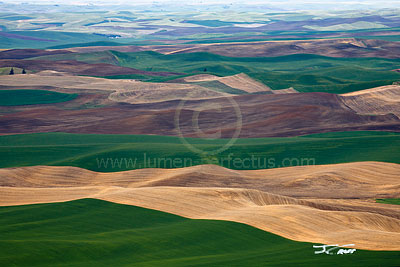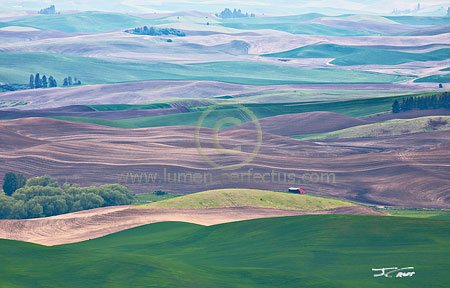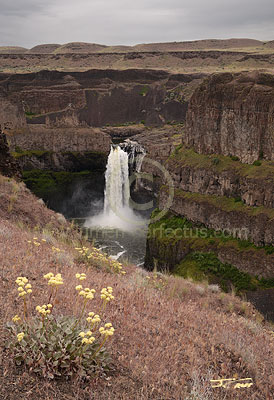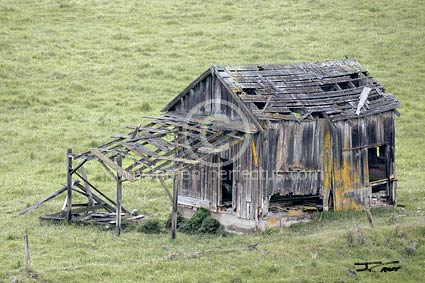www.lumen-perfectus.com
The Palouse
“Who will help me to plant this grain of wheat?”
Little Red Hen (folk tale)
When my wife and I moved from northeastern Ohio to western Montana, we expected our new location would be a good launch point for explorations of the western United States and Canada. I especially looked forward to spending time along the coasts of Washington and Oregon. We've lived here now several years. So far most of our travel has been fairly local: Glacier National Park, the Flathead, Mission, and Bitterroot valleys, and a bit farther afield to Yellowstone and Grand Teton National Parks and surrounding areas in Montana, Wyoming, and Idaho. There's so much to explore right here, or within just a few hours' driving time.

Wheat and newly-planted fields in The Palouse, photographed from Steptoe Butte on a rainy day.
This spring, instead of our usual May trip to Yellowstone, we decided to visit The Palouse region in eastern Washington. The Web is your resource for photos and articles about The Palouse; I won't relate facts and statistics you can easily find through your favorite search engine. I'd looked at many pictures and read quite a lot while researching the area. It's not a long drive from where we live, and most of that drive is lovely on its own. There's no bad time to go, so near the end of May's third week we tossed some photo gear in the car and headed west.
Spokane: Crowds, Noise, Great Food
Our first stop was Spokane, WA. We walked around the downtown area; visited the extensive park along the river; had an excellent lunch; spent a few bucks in the big shopping mall on things for which one needs a mall, as those who live in mall-free small towns will understand; had a wonderful dinner and a little too much wine; and walked that off by heading downtown to watch the annual Lilac Parade from a nice vantage point (as in photography, if you can't be good, be lucky; we were in finding a good spot from which to view this very crowded event). It was all great fun, but I must confess that a few hours of the crowds and traffic one encounters on a warm spring Saturday in the Big City left me feeling a little frantic and longing for some peace and quiet. One certainly gets used to living in a small town.
Really, It's That Green!
Sunday dawned cloudy and gray. We drove south from Spokane toward Colfax and Pullman, WA, in the rain. Poor conditions for the landscape photography I'd planned, but fine for exploring, for scouting locations for when the weather was more cooperative.

Another from Steptoe Butte in the rain. In larger prints, the tiny red shed makes the picture. Better light would have made it a better picture.
The Palouse is like a golf course: an entirely man-made environment. This is wheat country, the second-most productive wheat growing region in the world (the Ukraine being first). While the hills and rivers and buttes are the result of ancient lava flows and the great floods from Glacial Lake Missoula, photography in The Palouse is all about barns, windmills, grain elevators, and the machinery and infrastructure of grain farming. Of particular fascination for me were the geometric patterns and colors of the wheat and canola (rape seed) fields, the fallow fields, recently tilled areas, and the grid of highway, local, and “primitive” (gravel and dirt) roads. In the second half of May, many, perhaps a third, of the fields were the tans and browns of freshly plowed earth, made darker by the continuing rain. Other fields showed a haze of chartreuse—new shoots only a few inches high, in long, curving rows. We saw brilliant green wheat a foot high, and some expanses of canola nearly four feet (1.2m) tall.
The colors, even in (perhaps because of) the soft lighting of the gray skies, were sometimes eye-popping. Working through these images later in Photoshop, I wanted to lower the saturation to make the colors, especially yellows and greens, more believable. Doing so altered the colors in a way I didn't like, so I left the saturation as it came from the camera.
As the season progresses, the fields will fill with green and yellow, change to a deep golden color, and eventually be harvested, leaving long, curving row patterns in the fields. The terrain is perfect for capturing the long shadows of morning or evening sun. On sunny days with large, puffy clouds the hills will be dappled with light and shadow. I've seen a few photos from The Palouse in winter; the snow-covered fields and farm buildings are beautiful in snow when the light is just right. There's no bad time to photograph The Palouse.
A 200-Foot (61m) Waterfall

Palouse Falls during a break in the rain on a gloomy afternoon.
We spent most of our first day in The Palouse in the car, exploring. It rained nearly all day, was chilly and blustery. We drove through Colfax to Pullman, crossed the Idaho border into Lewiston and then crossed back into Washington at Clarkston, drove to the far southwestern corner of The Palouse to Palouse Falls. This is approaching the western edge of The Palouse where the terrain begins to give way to the scablands. The rain stopped long enough for lunch and some gray-sky photography at Palouse Falls. We'll almost certainly make use of the campground there for future trips. The impressive falls and its canyon are probably best photographed near sunset. From the falls we made our way back to Colfax, which would be our base for the remainder of the trip.
On the return drive to Colfax through the middle of The Palouse we stopped in the rain several times to attempt some picture taking. I got soaked setting up my panorama rig along a canola field, but to make up for that, the resulting photos have a gloomy feel, likely not the best interpretation of the scene. I really like the compostion I got after cropping the 30-frame capture. In better lighting, perhaps on one of those sun-and-puffy-cloud days I mentioned, it would be a keeper. Maybe next time.
Sheds 'n' Shacks
Thanks to the poor weather, we spent much of the remainder of the trip in the car. There are a number of loop drives one can make starting in Colfax or Pullman or Palouse (the city); we did those, but to see the best of The Palouse, it's necessary to get off the pavement and use the roads marked “primitive”. These roads might be trouble after extended rains or in winter (most are not plowed), but we found the dark gravel surfaces to be in fine shape, and wet enough so they weren't dusty. We sought out hills from which we could look down across the fields. We found dozens of broken-down old farm buildings, a subject I find very appealing. Along with the barns and sheds, there are abandoned grain elevators, broken-down fences, and collapsing houses that stand on their own (not for much longer, in some cases) as subjects, also providing pattern and texture for close-up work and abstracts. The Palouse is a gold mine if you enjoy looking at and photographing these old derelicts.

The remains of a shed along a creek-bed.
We drove to the top of Steptoe Butte, which provides excellent elevation for the “grand scenic” vista. Unfortunately, the clouds and rain provided a fairly constant haze, killing the contrast needed to bring out the details in the unique landscape of The Palouse.
While up on the butte we saw what was likely a photo workshop group trying to get started. It was pouring rain. One of the participants, wearing appropriate rain gear, had set up several tripods behind their van while the other three members of the group waited inside. He gave up after a few minutes standing in the rain. The tripods were collapsed and stowed in the van, and the group drove off toward the top of the butte. Later in the morning we saw the same van, still on the butte. The four photographers were spread out along the road photographing the valley below. Was that you, in the big white van with California license plates?
This wasn't a productive trip for me photographically. I made fewer than 200 exposures, including several dozen along the Flathead River in Montana during the drive home. But we learned much about where to photograph in The Palouse next time, when perhaps the weather will be nicer for photography and camping.
I've created a new gallery on the site to be populated with a few photos from this trip, and many more from future visits to The Palouse.
May, 2012